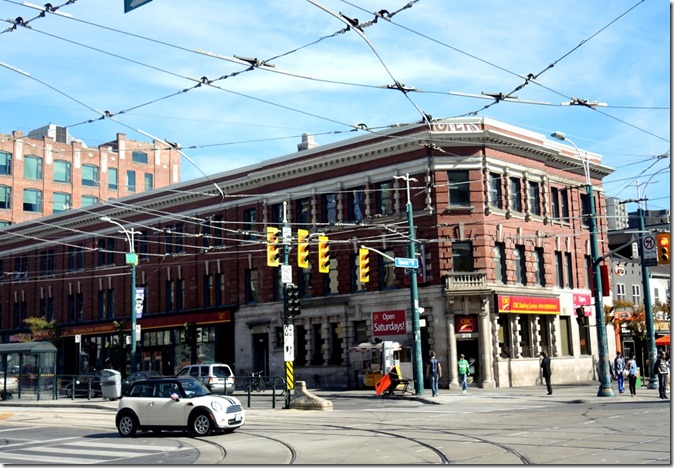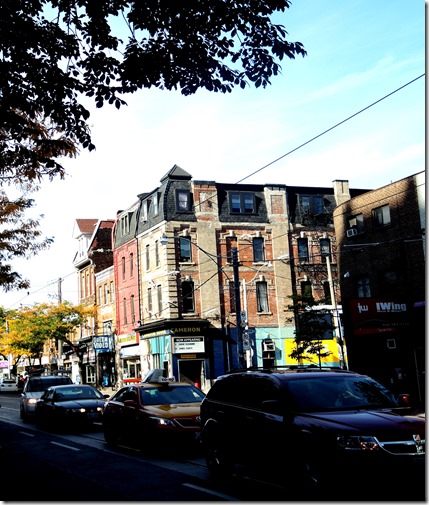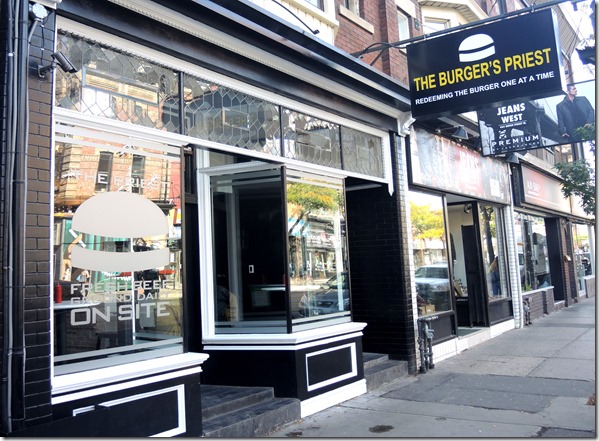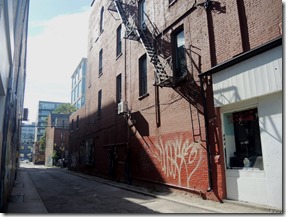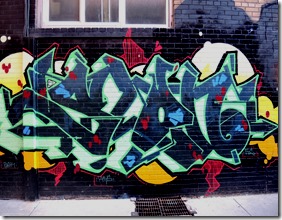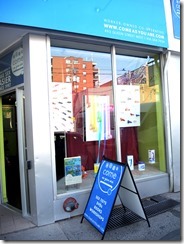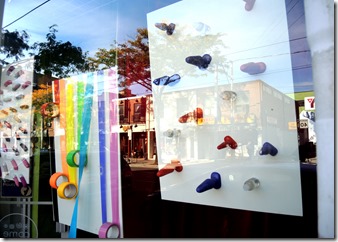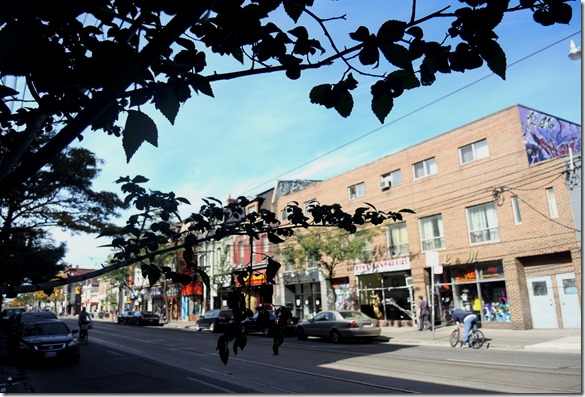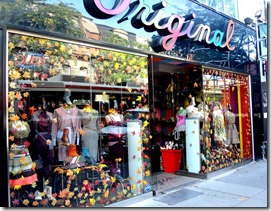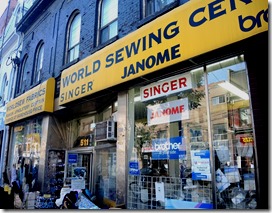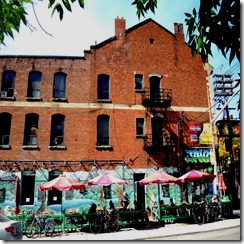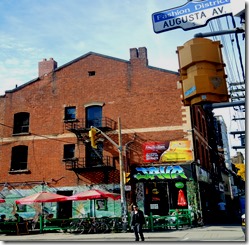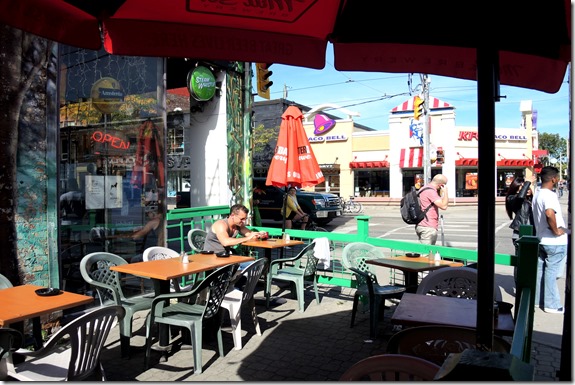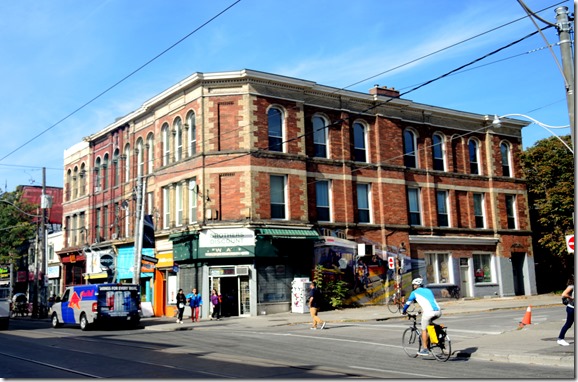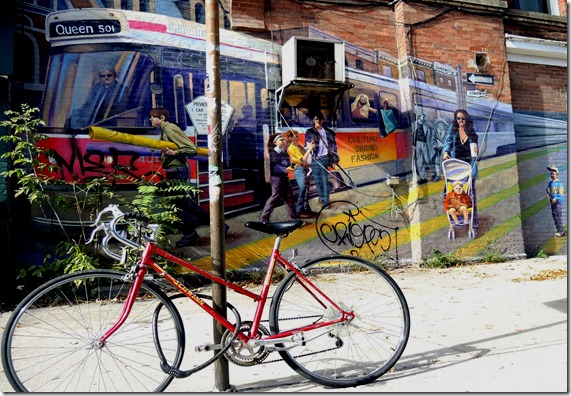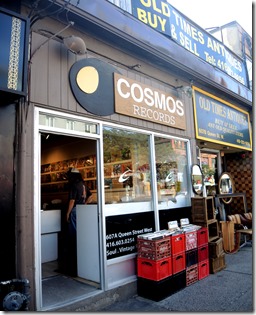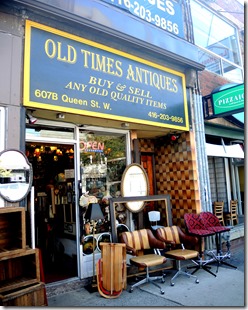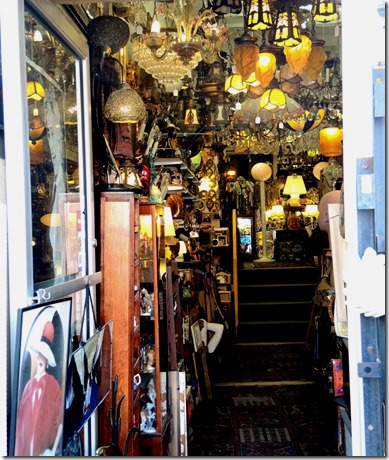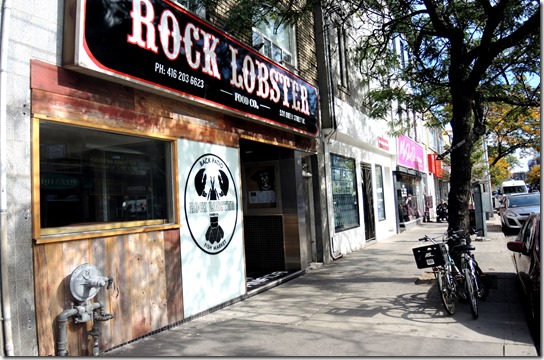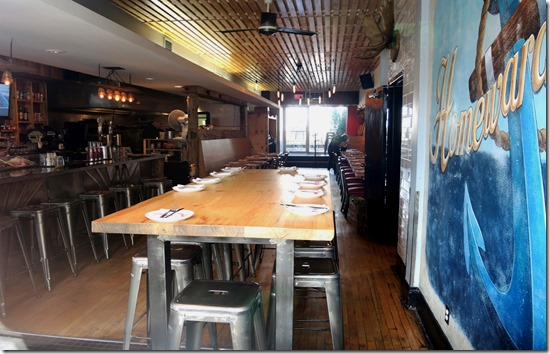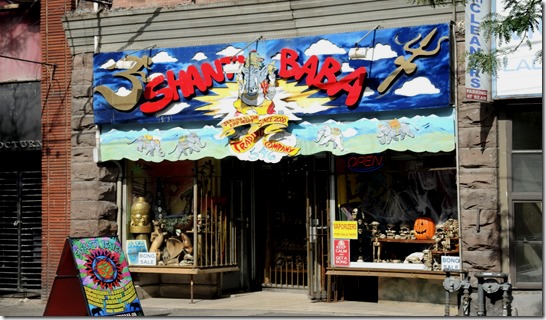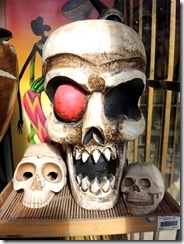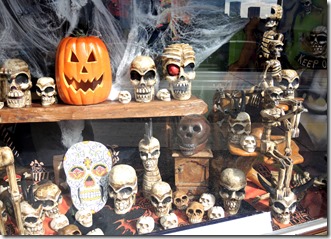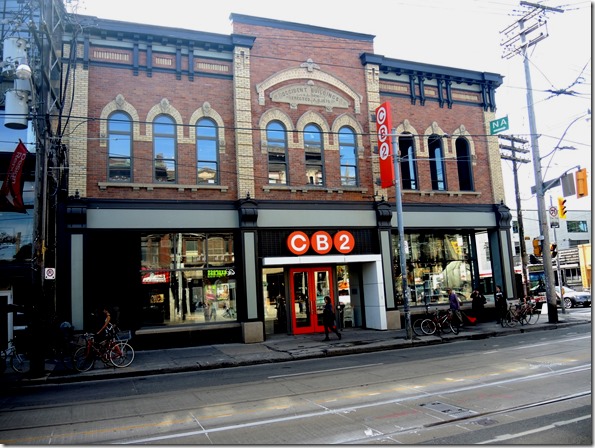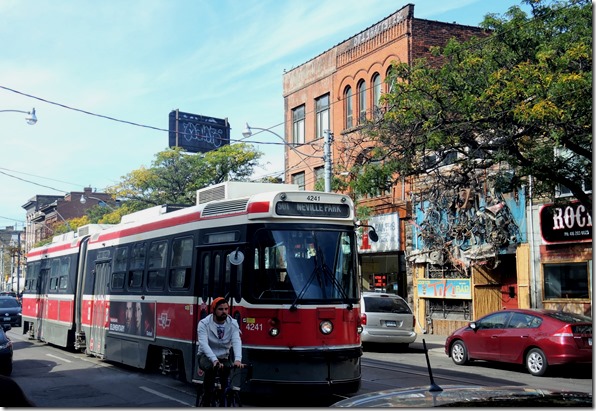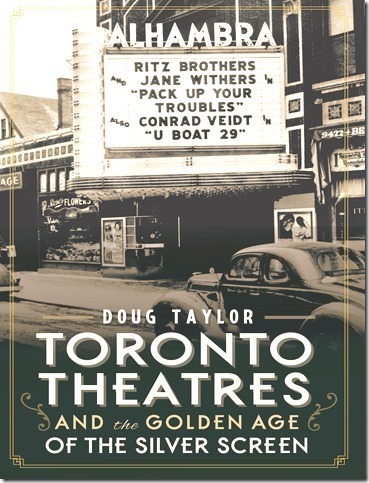The former Bank of Hamilton on the northeast coroner of Spadina Avenue and Queen Street West.
This is the second post providing a snapshot view of Queen Street West on October 5,2013, exploring the street from Spadina Avenue, west to Bathurst Street.
The Cameron House at 408 Queen Street, on the northwest corner of Queen West and Cameron Street is a well-known institution. To view a post about this famous pub.
The Burger’s Priest is the latest (summer 2013) hamburger restaurant to open near the corner of Queen and Spadina. The major problem with this cafe is that it is so popular that it is difficult to get inside the door. I do not know why there are so many hamburger places near this intersection, but I placed a post on this blog referring to Queen and Spadina as “hamburger corner.”
For a link to this post: https://tayloronhistory.com/2012/10/10/torontos-hamburger-cornerwhere-is-it-and-why/
Continuing west on the south side of Queen Street, a short distance west of Spadina is McDougall Lane, which gives access to Graffiti Alley. This notorious/famous laneway runs parallel with Queen Street, between Spadina and Bathurst Street. It is perhaps the best place in Toronto to view street art. To view a link to posts about the graffiti artist Uber5000, one of Toronto’s best known street artists:
https://tayloronhistory.com/2013/05/20/toronto-graffitiuber5000-does-it-again/
This shop is named “Come as You Are.” It is on the south side of Queen, a short distance west of McDougall Lane and has a window display that features condoms in all sizes and colours—very naughty.
These shops, on the north side of Queen West, to the west of Cameron Street, are housed in a mixture of modern and 19th-century buildings. Fortunately the modern structures are the same height as the old, so the streetscape maintains a sense of cohesion. However, the facades of the modern buildings are smooth and lack the texture that the older structures provide.
These shops, between Spadina and Augusta avenues add colour to the streetscape. Their crowded window displays attract many shoppers and provide interesting views for those strolling along the street.
The Java House, contained within a 19th-century building, has one of the most popular summer-time patios on the strip for enjoying a coffee, beer, or light meal. It is on the southwest corner of Queen West and Augusta.
The patio of the “Java House,” is on the east side of the building. The food is quite good and as a place for observing the passing scene, it is superb.
This 19th century block of buildings is on the northwest corner of Queen West and Denison Avenue. The side of the building that faces on Denison Avenue has an interesting mural.
Mural on the Denison Avenue side of the building on the northwest corner of Denison and Queen West. It depicts the famous “501” streetcar on Queen, rated as one of top ten trolley lines in the world, and the only one that remains a functioning public transit line, as opposed to being maintained primarily for tourists.
This 19th-century building is on the northeast corner of Queen and Ryerson Avenue. It houses “The Hideout,” another of the well-known pubs and entertainment venues of Queen West.
“Cosmos”(left photo) was selling vinyl records before it became popular elsewhere in the city. The “Old Times Antiques” shop (right-hand photo) is a favourite of many who stroll Queen Street to browse for bargains.
Gazing in the doorway of the “Old Times Antiques” shop.
The “Rock Lobster” is a new addition to the street (2013), located where the hamburger place “Shanghai Cowgirl” was formerly located. The Rock Lobster has a great back patio, and serves seafood in the manner of a Spanish tapas restaurant. The lobster rolls are to die for. This restaurant is very busy most evenings with a young vibrant crowd.
Interior of the Rock Lobster, looking toward the patio on the north end of the restaurant.
As a person approaches Bathurst Street, other colourful shops appear. This is the Shanti Baba Shop.
Window display in the Shanti Baba Shop.
On the southeast corner of Bathurst and Queen West is an historic building that was gutted to accommodate the CB2 store. In the 19th century the site was a Masonic Temple. The facade of the structure has been lovingly restored to showcase its attractive red and yellow bricks. For a link to the history of the building:
https://tayloronhistory.com/2013/05/06/torontos-architectural-gems-building-at-queen-and-bathurst/
The 501 Streetcar line is an important part of the streetscape, it rattling wheels as much a part of the scene as the trendy shops and eclectic crowds.
For a link to part one of this post:
https://tayloronhistory.com/2013/10/20/torontos-gemsqueen-st-westpart-ithe-naughty-and-nice/
To view the Home Page for this blog: https://tayloronhistory.com/
To view previous blogs about other movie houses of Toronto—old and new
https://tayloronhistory.com/2013/10/09/links-to-toronto-old-movie-housestayloronhistory-com/
To view links to other posts placed on this blog about the history of Toronto and its buildings:
https://tayloronhistory.com/2013/10/08/links-to-historic-architecture-of-torontotayloronhistory-com/
Book published in 2014 about Toronto’s old movie theatres, which explores 50 of Toronto’s old theatres and contains over 80 archival photographs of the facades, marquees and interiors of the theatres. It also relates anecdotes and stories from those who experienced these grand old movie houses.
“Toronto’s Theatres and the Golden Age of the Silver Screen”
To place and order for this book, either in electronic or hard copy format, follow the link below.
Theatres Included in the Book
Chapter One – The Early Years—Nickelodeons and the First Theatres in Toronto
Theatorium (Red Mill) Theatre—Toronto’s First Movie Experience and First Permanent Movie Theatre, Auditorium (Avenue, PIckford), Colonial Theatre (the Bay), the Photodrome, Revue Theatre, Picture Palace (Royal George), Big Nickel (National, Rio), Madison Theatre (Midtown, Capri, Eden, Bloor Cinema, Bloor Street Hot Docs), Theatre Without a Name (Pastime, Prince Edward, Fox)
Chapter Two – The Great Movie Palaces – The End of the Nickelodeons
Loew’s Yonge Street (Elgin/Winter Garden), Shea’s Hippodrome, The Allen (Tivoli), Pantages (Imperial, Imperial Six, Ed Mirvish), Loew’s Uptown
Chapter Three – Smaller Theatres in the pre-1920s and 1920s
Oakwood, Broadway, Carlton on Parliament Street, Victory on Yonge Street (Embassy, Astor, Showcase, Federal, New Yorker, Panasonic), Allan’s Danforth (Century, Titania, Music Hall), Parkdale, Alhambra (Baronet, Eve), St. Clair, Standard (Strand, Victory, Golden Harvest), Palace, Bedford (Park), Hudson (Mount Pleasant), Belsize (Crest, Regent), Runnymede
Chapter Four – Theatres During the 1930s, the Great Depression
Grant ,Hollywood, Oriole (Cinema, International Cinema), Eglinton, Casino, Radio City, Paramount, Scarboro, Paradise (Eve’s Paradise), State (Bloordale), Colony, Bellevue (Lux, Elektra, Lido), Kingsway, Pylon (Royal, Golden Princess), Metro
Chapter Five – Theatres in the 1940s – The Second World War and the Post-War Years
University, Odeon Fairlawn, Vaughan, Odeon Danforth, Glendale, Odeon Hyland, Nortown, Willow, Downtown, Odeon Carlton, Donlands, Biltmore, Odeon Humber, Town Cinema
Chapter Six – The 1950s Theatres
Savoy (Coronet), Westwood
Chapter Seven – Cineplex and Multi-screen Complexes
Cineplex Eaton Centre, Cineplex Odeon Varsity, Scotiabank Cineplex, Dundas Square Cineplex, The Bell Lightbox (TIFF)
